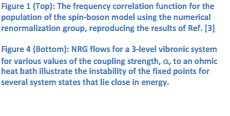Reports: ND653301-ND6: A Theoretical Study of Coherent Energy Transport in Polymers
Joel Eaves, PhD, University of Colorado
Summary. The funding this project provided allowed us to investigate fundamental and unconventional energy transfer mechanisms in polymers and acene molecules that are important to petroleum research. The funding provided training for one graduate student, two postdocs, and allowed the PI to spend two summer months conducing research. The successful completion of this project resulted in the publication of two papers [1,2] and has allowed us to take risks in research that put us in a strong position to secure more funding from other agencies. We are grateful to the donors of the PRF for their support.
Triplet-triplet entanglement in acene crystals. One project that the PRF funding supported developed a model to describe triplet-triplet annihilation in ideal crystals and focused on the collective aspects of exciton dynamics, including a quantifiable measure of quantum entanglement between triplet excitons (Fig. 1). [2] This paper shows that molecular acene crystals can exhibit long-ranged quantum entanglement between triplet pairs born from an optically excited singlet, and provides, for the first time, a quantitative measure of this entanglement. Molecular acene crystals show some promise to be a new “lab bench” for conducting experiments in quantum information theory with entangled triplet excitons.
Number fluctuations in vibrational dephasing. The original research direction proposed examined the interplay between vibrational and electronic degrees of freedom in promoting efficient energy transfer in polymers. In a second paper, we produced theory and calculations for describing vibrational dephasing, an inherently statistical phenomenon, for microscopy experiments that are outside of the statistical, or ensemble, limit (Fig. 2).[1] We applied this theory to novel vibrational microscopy experiments on polytetrafluoroethylene (PTFE). This is the first theory for real-time vibrational dephasing at the few-molecule limit. This work raises and addresses how finite sized systems, or number fluctuations, influence apparent dephasing rates. Going forward, we want to understand how the statistics of these fluctuations can provide information for models of quantum dissipative systems. Now that there are experiments capable of the appropriate measurements, these questions are much more urgent.
Numerically exact methods for vibronic dynamics. The grant proposal aimed to use the numerical renormalization group (NRG) to compute numerically exact dynamics for multistate energy transfer pathways in polymers without resorting to perturbation theories. This aspect of the project ended up being both risky and time-consuming. It was also quite interesting.
In the initial phases of this project, we focused on a donor-acceptor vibronic energy transfer system as a model for intramolecular and intramolecular energy transport in polymers. We are using numerical methods to explore energy transfer in regions where the intrasite coupling is similar to the intersite coupling. Crucially, we are exploring the role of correlated vibrational motions, strongly coupled to the electronic degrees of freedom. We began our investigations using the numerical renormalization group (Fig. 3 and 4). While, initially, these results appeared promising, we found significant fundamental shortcomings with the method when applied to multilevel systems and to systems with vibrational degrees of freedom. The problems with these methods appear to be rooted in the structure of the many-body eigenvalue problem when several system degrees of freedom (more than two) are included. The numerical renormalization group frames the quantum relaxation problem as a many-body problem, and iteratively diagonalizes a large matrix to find the eigenvalues of the many-body Hamiltonian. When the system includes either several energy levels or correlated vibrational motions, the numerical fixed points are nontrivial, and the flow after several iterations of the method becomes unstable (Fig. 4). Various methods, such as z-averaging,[3] do not seem to help. A much more promising direction is based on a vibronic version of the hierarchy equations of motion (HEOM) approach for vibronic systems, though carrying this out is complicated because one has to devise an appropriate action for both discrete and continuous degrees of freedom. We think that this approach is promising, and will continue to develop this method.
References Cited
1. Atkin, J.M., P.M. Sass, P.E. Teichen, J.D. Eaves, and M.B. Raschke, Nanoscale Probing of Dynamics in Local Molecular Environments. Journal of Physical Chemistry Letters, 2015. 6(22): p. 4616-4621.
2. Teichen, P.E. and J.D. Eaves, Collective Aspects of Singlet Fission in Molecular Crystals. Journal of Chemical Physics, 2015. 143(4): p. 044118.
3. Bulla, R., H.J. Lee, N.H. Tong, and M. Vojta, Numerical Renormalization Group for Quantum Impurities in a Bosonic Bath. Physical Review B, 2005. 71(4): p. 045122.

















